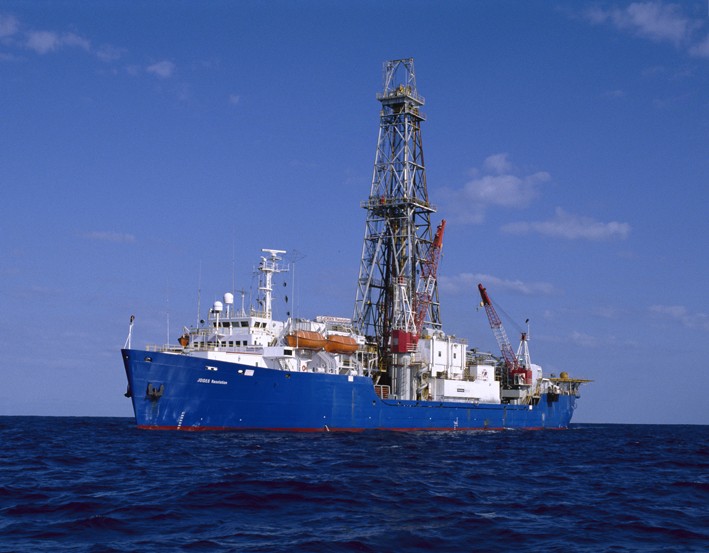News Release 05-211
Revered Scientific Drilling Ship Gets Extreme Makeover
December 21, 2005
This material is available primarily for archival purposes. Telephone numbers or other contact information may be out of date; please see current contact information at media contacts.
After 20 years of service, the JOIDES Resolution, the pioneering scientific ocean drilling vessel that allowed scientists to retrieve samples of the Earth’s crust and sediments from deep beneath the ocean, is undergoing an extreme makeover.The new and improved vessel, which promises to increase the quality and rate of core samples brought up from the deep, will be virtually unrecognizable from the old ship and will be given a new name. It is estimated the new research vessel will be ready for science expeditions in mid-2007.
Scientists have conducted 122 expeditions onboard the 470-foot (143-meter) JOIDES Resolution, first through the Ocean Drilling Program (ODP, 1985-2003) and now in the Integrated Ocean Drilling Program (IODP, 2003-present).
Over the ship’s 20-year history, the core samples it has recovered have helped scientists validate the theory of plate tectonics, provided extensive information about Earth’s past climate, and found evidence of the catastrophic asteroid impact that wiped out the dinosaurs 65 million years ago.
"The enhanced vessel will greatly increase the efficiency and scope of drillship scientific operations, allowing IODP scientists to continue expanding our knowledge of the Earth," said Jamie Allan, program director for IODP at the National Science Foundation (NSF), which is funding the effort.
“To get a sense for the kinds of improvements, imagine how Steve Austin was rebuilt to become the Six Million-Dollar Man,” said Steve Bohlen, president of Joint Oceanographic Institutions (JOI), Inc. The JOI Alliance is the U.S. implementing organization for IODP, and is responsible for the vessel's science operations.
The JOI Alliance is funded by NSF and consists of JOI, which has the principal responsibility for overseeing programmatic, contractual, and fiscal management activities; Texas A&M University, which subcontracts drill ship operations, conducts platform-related tool development, and provides expedition staffing, logistics, engineering development, outfitting of shipboard laboratories, shipboard- and shorebased-curation of samples, and distribution of core samples and data; and the Lamont-Doherty Earth Observatory of Columbia University, which provides downhole logging tools and support and log data processing, distribution, and database services.
JOI has a 10-year, $626 million contract with NSF, signed in Sept. 2003, after a competitive bid process, to provide integrated science services in support of the U.S. drillship for IODP. Under the contract, this drillship was selected in open competition, with an NSF-approved contact signed in Dec. 2005, between Overseas Drilling Limited, the provider of the vessel, and Texas A&M University Research Foundation, science operator and subcontractor to JOI, for $288 million.
During its history, the vessel has been adapted and upgraded several times. But the scale of the conversion planned now will be far beyond any past upgrades, said Allan, "and the finished vessel will meet the expanding needs of ocean-drilling scientists for a generation to come."
There will be at least a 50 percent increase in laboratory space aboard ship, allowing for a greater variety of instrumentation that onboard scientists can use to analyze cores samples while at sea.
An enhanced drilling instrumentation system, a sub-sea camera system with improved handling, and a new drill string with upgraded drilling tools will allow the crew to retrieve core samples faster and with better quality. Changes to the ship's hull and machinery will improve the fuel efficiency and increase the transit speed, allowing for more time "on station."
Gone are the days of crowded four-person staterooms and shared bathrooms, much to the delight of the scientists and crew who live aboard the vessel during expeditions, which last two months on average. Instead, rooms on the enhanced ship will be double occupancy with an adjacent bathroom. During the conversion, space for 23 additional berths will be added.
With the start of the Integrated Ocean Drilling Program (IODP) and the construction of the Japanese-built drilling vessel Chikyu (Japanese for Earth,) which is scheduled to begin IODP expeditions in 2007, the U.S. government is fulfilling its commitment to provide a state-of-the-art scientific ocean drilling vessel to the international research community.
-NSF-
Media Contacts
Cheryl Dybas, National Science Foundation, (703) 292-7734, email: cdybas@nsf.gov
Jon Corsiglia, Joint Oceanographic Institutions, Inc., (202) 232-3900, email: jcorsiglia@joiscience.org
Nancy Light, IODP-Management International, (202) 465-7511, email: nlight@iodp.org
Related Websites
IODP: www.iodp.org
The U.S. National Science Foundation propels the nation forward by advancing fundamental research in all fields of science and engineering. NSF supports research and people by providing facilities, instruments and funding to support their ingenuity and sustain the U.S. as a global leader in research and innovation. With a fiscal year 2023 budget of $9.5 billion, NSF funds reach all 50 states through grants to nearly 2,000 colleges, universities and institutions. Each year, NSF receives more than 40,000 competitive proposals and makes about 11,000 new awards. Those awards include support for cooperative research with industry, Arctic and Antarctic research and operations, and U.S. participation in international scientific efforts.
Connect with us online
NSF website: nsf.gov
NSF News: nsf.gov/news
For News Media: nsf.gov/news/newsroom
Statistics: nsf.gov/statistics/
Awards database: nsf.gov/awardsearch/
Follow us on social
Twitter: twitter.com/NSF
Facebook: facebook.com/US.NSF
Instagram: instagram.com/nsfgov



